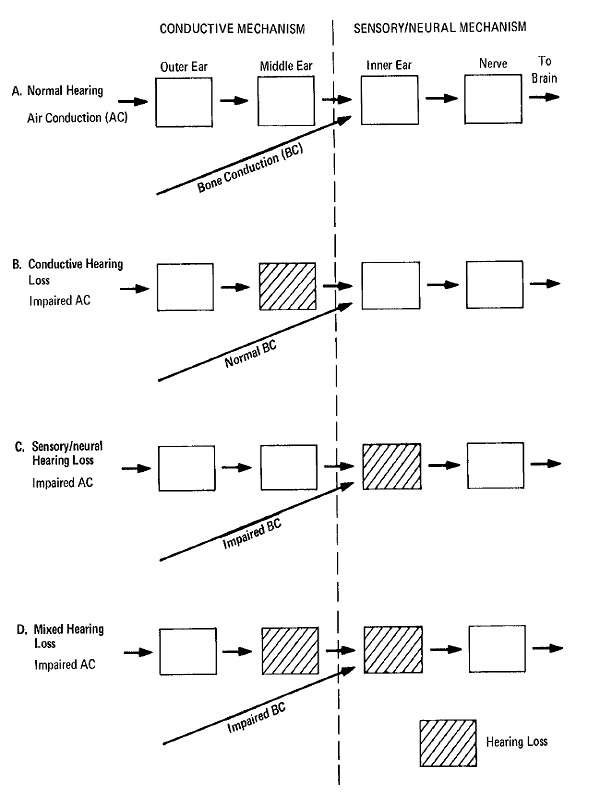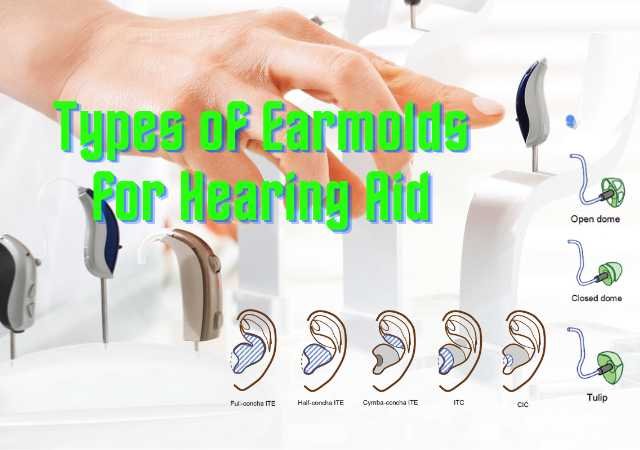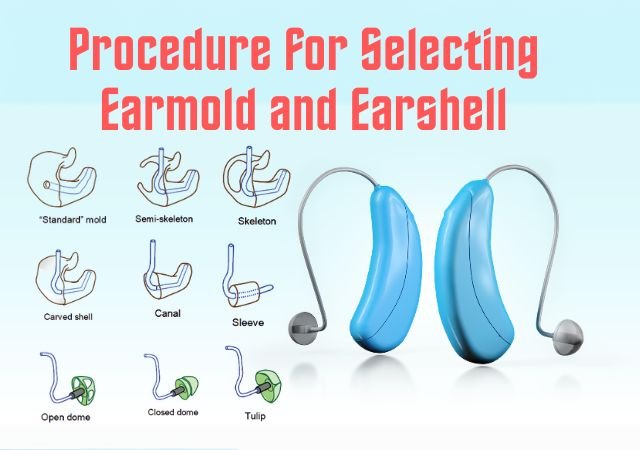What is Hearing Loss and its type?: Hearing, or auditory perception, is the ability to perceive sounds through an organ, such as an ear, by detecting vibrations as periodic changes in the pressure of a surrounding medium.
Hearing Loss
A person who is not able to hear as well as someone with normal hearing – hearing thresholds of 20 dB or better in both ears – is said to have hearing loss. Hearing loss may be mild, moderate, severe, or profound. It can affect one ear or both ears, and leads to difficulty in hearing conversational speech or loud sounds.
‘Hard of hearing’ refers to people with hearing loss ranging from mild to severe. People who are hard of hearing usually communicate through spoken language and can benefit from hearing aids, cochlear implants, and other assistive devices as well as captioning.
‘Deaf’ people mostly have profound hearing loss, which implies very little or no hearing. They often use sign language for communication.
– World Health Organization (WHO 2021)
Types of Hearing Loss
The three major classifications of hearing impairment are Conductive, Sensorineural, and Mixed. An another type of hearing loss is Functional Hearing loss.

Block diagram of the pathway of sound conduction. A conductive hearing loss is illustrated by damage to the middle ear. Damage to the outer ear would produce the same effect. Similarly, a sensory/neural hearing loss could be illustrated by damage to the hearing nerve as well as to the inner ear.
Conductive Hearing Loss
It is caused by any disease process interfering with the conduction of sound from the external ear to the stapediovestibular joint. Thus the cause may lie in the external ear (obstructions), tympanic membrane (perforation), middle ear (fluid), ossicles (fixationm or disruption) or the eustachian tube (obstruction).
A conductive hearing loss is present if the bone-conduction thresholds are within normal limits, air-bone gaps of 15dB or more are present, and the air conduction thresholds are outside the normal limits, that is, are 25 dB HL or less. We consider bone-conduction thresholds to be within normal limits only if they are 15 dB HL or better. Thus, a conductive hearing impairment is characterized by good bone-conduction thresholds, signalling the absence of a problem in the sensorineural mechanism, significant air-bone gaps, signaling better hearing sensitivity by bone conduction than by air conduction, and poor air-conduction thresholds, signalling a problem in the outer and/or middle ear (inner-problem ruled out by the good bone-conduction thresholds).
These are some indications of Conductive Hearing Loss
- History of ear infections.
- History of ear discharge.
- Outer ear and Middle ear are affected.
- Impaired Air-conduction and Normal Bone-conduction.
- The audiometric configuration may be Flat.
- Not difficulty in hearing in noisy environment apart from having any degree of hearing.
- Caused by damage to the middle ear.
- Blockage of ear canal.
- Sound Attenuation is precisely the result of a Conductive hearing loss.
- In this type of hearing loss the maximum degree of loss may be moderately severe.
Major Etiologies of Conductive Hearing Loss
External Ear
- Atresia – The absence of the external auditory meatus because of failure in embryologic development is called Atresia.
- Cerumen Impaction – Cerumen, or ear wax produced by glands underneath the skin of the external auditory meatus, lubricates the skin, prevents foreign bodies from entering the ear canal, and protects against maceration. The cerumen usually migrates laterally and falls out of the ear canal.
- Foreign Bodies in the External Auditory Meatus – Foreign bodies such as beans, cotton, roaches, buttons, paper, or pens may be present in the ear canal.
- Bony Growths – Exostoses are multiple, hard bony growths of the ear canal covered with skin.
- External Otitis – an infection of the skin of the external auditory meatus, is also known as “swimmer’s ear.”
Middle Ear:
- Tympanic Membrane Perforations – Tympanic membrane perforations are caused by direct trauma to the tympanic membrane (for example, from bobby pins), indirect trauma (for example, from pressure from a slap on the head or explosion near the ear) etc.
- Tympanosclerosis – It is a condition characterized by the formation of white plaques on the tympanic membrane, causing thickening and scarring of the tympanic membrane.
- Otitis Media – It is an inflammation of the middle ear. When there is bacterial infection of the associated middle ear effusion and pus is present, the condition is termed acute purulent otitis media.
- Otosclerosis – It is a disease of the labyrinthine capsule and stapedial footplates.
- Cholesteatoma – It is a cyst which usually occurs in the middle-ear cavity but may occur in the temporal bone.
- Glomus Jugulare and Glomus Tympanicum Tumors – Glomera jugularae are very small, neural bodies that are normally present in the body (Jerger & Jerger, 1981).
- Ossicular Discontinuity – A break anywhere along the ossicular chain, often occurs in cases of head trauma or may be a congenital malformation of the middle ear.
Sensorineural Hearing Loss
It results from lesions of the cochlea (sensory type) or VIIIth nerve and its central connections (neural type). The term retrocochlear is used when hearing loss is due to lesions of VIIIth nerve, and central deafness, when it is due to lesions of central auditory connections.

what-is-hearing-loss-and-its-type
A sensorineural hearing impairment is present if the bone-conduction thresholds are outside of the normal limits, that is, greater than 15 dB HL, no significant air-bone gaps are present (i.e., air-bone gaps do not exceed 10 dB), and the air-conduction thresholds are outside of the normal limits, that is, are greater than 25 dB HL. Thus, a sensorineural hearing impairment is characterized by poor bone-conduction thresholds, signaling a problem in the sensorineural mechanism, and essentially equally poor air-conduction thresholds.
These are some indications of Sensorineural Hearing Loss
- Impaired Air-conduction (because of impaired bone-conduction other than the air-conduction pathway is normal) and impaired Bone-conduction.
- The Air-bone gaps are less than 10 dB HL.
- Sensorineural mechanism (Inner ear or auditory pathway) is affected.
- Problem in hearing in telephone and noisy place.
- Difficulty in female and child voice (in high frequency sensorineural hearing loss)
- The audiometric configuration may be Gradual or Slopping.
- May be caused by exposure to loud noise.
- This type of hearing loss is progressive.
- Reduce interaction with others and avoid movies, theatre and religious services because trouble in understanding the words.
Major Etiologies of Sensorineural Hearing Loss
Congenital
- Genetic – Some genetic forms of hearing impairment are associated with other anomalies, although most are not. Those associated with other genetic anomalies are usually called syndromes (Konigsmark, 1971).
- Nongenetic – Etiologies of nongenetic congenital hearing impairment may be maternal infection, birth complications such as asphyxia or anoxia, accident during pregnancy, malformation during embryologic development, drugs, or metabolic disorders.
Adventitious
Adventitious hearing impairment is postnatally acquired hearing impairment. Causes of adventitious hearing impairment include-
- Idiopathic
- Trauma
- Drug
- Noise
- Aging
- Systemic Disease
- Infections
- Acoustic Schwannomas
Mixed Hearing Loss
In this type, elements of both conductive and sensorineural deafness are present in the same ear.
A mixed hearing impairment is present if the bone-conduction thresholds are outside of the normal limits, that is, greater than 15 dB HL, significant air-bone gaps exceeding 10 dB HL are present, and the air-conduction thresholds are outside of the normal limits, that is, are greater than 25 dB HL. Thus, a mixed loss is characterized by poor bone-conduction thresholds, signalling a problem in the sensorineural mechanism, significant air-bone gaps exceeding 10 dB, signalling better hearing sensitivity by bone conduction than by air conduction, and air conduction thresholds worse than the bone-conduction thresholds, signalling a problem in the outer and/or middle ear (conductive mechanism) in addition to the problem in the sensorineural mechanism indicated by the poor bone-conduction thresholds.
These are some indications of Mixed Hearing Loss
- Impaired Air-conduction and Bone-conduction both.
- Air-bone gaps are 10 dB HL or more than 10 dB HL.
- Conductive and Sensorineural mechanism both are affected.
- The audiometric configuration may be Rising or Slopping.
- In case of mixed hearing loss symptoms shown related to conductive hearing loss and sensorineural hearing loss both.
Functional Hearing Loss
Functional hearing loss involves a psychological or emotional problem, rather than physical damage to the hearing pathway. Individuals with this type of hearing loss do not seem to hear or respond; yet, in reality, they have normal hearing. The most important challenge for physicians is to classify this condition properly. It may be difficult to determine the specific emotional cause, but if the classification is made accurately, the proper therapy can begin.
References:
⇒ Deafness and Hearing Loss – World Health Organization (WHO)
⇒ Introduction to Audiology – Frederick N.Martin (Book)
⇒ Essentials of Audiology – Stanley A. Gelfand, PhD (Book)
You are reading about:
What is Hearing Loss and its type?







0 Comments